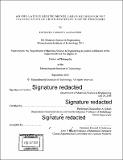| dc.contributor.advisor | Christopher A. Schuh. | en_US |
| dc.contributor.author | Alexander, Kathleen Carmody | en_US |
| dc.contributor.other | Massachusetts Institute of Technology. Department of Materials Science and Engineering. | en_US |
| dc.date.accessioned | 2017-04-18T16:37:51Z | |
| dc.date.available | 2017-04-18T16:37:51Z | |
| dc.date.issued | 2016 | en_US |
| dc.identifier.uri | http://hdl.handle.net/1721.1/108218 | |
| dc.description | Thesis: Ph. D., Massachusetts Institute of Technology, Department of Materials Science and Engineering, 2016. | en_US |
| dc.description | "September 2016." Cataloged from student-submitted PDF version of thesis. | en_US |
| dc.description | Includes bibliographical references (pages 155-171). | en_US |
| dc.description.abstract | Kinetic Monte Carlo (Kc) methods have the potential to extend the accessible timescales of off-lattice atomistic simulations beyond the limits of molecular dynamics by making use of transition state theory and parallelization. However, it is a challenge to identify a complete catalog of events accessible to an off-lattice system in order to accurately calculate the residence time for Kc. Possible approaches to some of the key steps needed to address this problem are developed in this thesis. After validating these methods in the study of vacancy diffusion, we implemented our off-lattice Kc method to study the kinetic behavior of the [Sigma]5 (210) grain boundary (GB) in copper. We found that the activation energy associated with intrinsic diffusion at this GB is between the activation energies of interstitial diffusion and vacancy diffusion. We have also measured GB mobility in this system and found the activation energy of GB migration to be similar to that of bulk diffusion. For comparison, we have performed a molecular dynamics study of this target GB and obtained diffusivity and mobility estimates that are sufficiently similar to our Kc results at high temperatures. At low temperatures, the molecular dynamics simulations did not yield meaningful predictions. The results of this case study indicate that the off-lattice Kc method developed herein may provide a means to study GB kinetic properties under conditions and timescales that were previously inaccessible. Towards the end of developing predictive relationships to describe GB kinetic properties, we have begun to assess whether the normalized ground state residence time of a GB is a good predictor of kinetic behavior by analyzing several low-CSL GBs. We see a clear relationship between normalized ground state residence time and kinetic properties for the GBs considered so far. A more thorough investigation will be required to establish whether or not these preliminary findings indicate a more general relationship. | en_US |
| dc.description.statementofresponsibility | by Kathleen Carmody Alexander. | en_US |
| dc.format.extent | 171 pages | en_US |
| dc.language.iso | eng | en_US |
| dc.publisher | Massachusetts Institute of Technology | en_US |
| dc.rights | MIT theses are protected by copyright. They may be viewed, downloaded, or printed from this source but further reproduction or distribution in any format is prohibited without written permission. | en_US |
| dc.rights.uri | http://dspace.mit.edu/handle/1721.1/7582 | en_US |
| dc.subject | Materials Science and Engineering. | en_US |
| dc.title | An off-lattice kinetic Monte Carlo method for the investigation of grain boundary kinetic processes | en_US |
| dc.title.alternative | Off-lattice Kc method for the investigation of GB kinetic processes | en_US |
| dc.type | Thesis | en_US |
| dc.description.degree | Ph. D. | en_US |
| dc.contributor.department | Massachusetts Institute of Technology. Department of Materials Science and Engineering | |
| dc.identifier.oclc | 980871433 | en_US |
